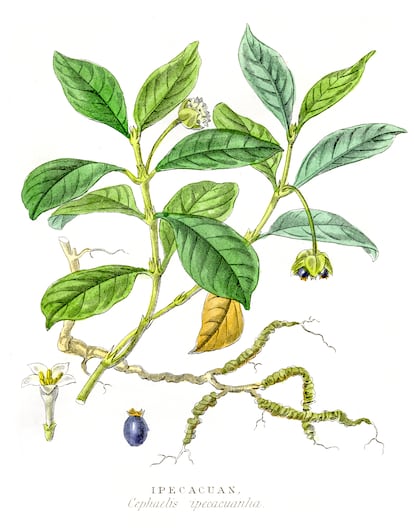Ipecac, the plant that killed Karen Carpenter, the star who was consumed by anorexia
The announcement of her death 40 years ago from heart failure failed to mention the poisoning caused by her addiction to the root of an ancient remedy

The recently published biography of 1970s pop star Karen Carpenter has brought to light that the announcement of her death from heart failure concealed a death due to slow poisoning derived from her addiction to ipecac root, an ancient Indigenous remedy banned from clinical practice since the end of the 20th century.
Ipecac, an old acquaintance of tropical phytotherapy
The written history of ipecacuanha (Carapichea ipecacuanha), the “roadside plant that makes you feel sick” in the Tupi language, begins when it arrived in Europe thanks to Willem Piso, in whose Historia Naturalis Brasiliae (1648) it was cited for the first time as a fever and vomit inducer used by the Amazon’s Indigenous people. The doctor Helvetius used it to treat the dysentery suffered by relatives of Louis XIV. Then, the plant disappeared from the history of the pharmacopoeia until it reappeared in the 18th century in the master formula of the famous Dover Powder, a cure-all based on ground ipecac root, opium and potassium sulfate that, like modern aspirin, was very popular to treat all types of feverish processes for 200 years.
Amoebic dysentery
Regarding dysentery, whose terrible effects killed thousands of people who died drenched in vomit and bloody diarrhea, one of the first milestones for its eradication occurred in 1875 when Fedor Lösch discovered an amoeba (known today as Entamoeba histolytica) in the feces of a patient who suffered from that disease.
In 1961, after overcoming research difficulties that seemed insurmountable, Louis Klein Diamond managed to cultivate the amoeba in vitro. The same decade in which E. histolytica was identified, two bacterial genera, Salmonella and Shigella, were found to cause other forms of dysentery. It was soon proven that ipecac root had no effect on these bacteria, which made it an effective diagnostic element for food poisoning.

Emetine hydrochloride
In the early 19th century, the Paris Chemical School discovered that ipecac root contained two powerful alkaloids, cephaleline and emetine (methylcephealine), which caused continuous vomiting and diarrhea. Emetine is obtained by direct extraction from the ipecac root or by methylation of cephaelin in the laboratory.
Emetine has many pharmacological capabilities. In eukaryotic cells, it inhibits protein synthesis, preventing the bonding of peptide chains. In mammals, it blocks mitochondrial oxidative phosphorylation, interrupting the functioning of cellular respiration and causing important alterations in the heart and nervous system.
Hospital practice proved it to be extremely effective in eradicating amebiosis dysentery, but it presented considerable practical difficulties. To begin with, the patient had to remain at complete rest during the treatment. Furthermore, it had to be administered by injection and the dosage needed to be precisely adjusted. On the other hand, it was essential to maintain close observation to detect reactions in the gastrointestinal tract (vomiting and diarrhea), the nervous system (polyneuritis) and, above all, potentially fatal cardiovascular alterations, including hypotension and tachycardia.
If either of these appeared, treatment had to be stopped immediately because, despite strict precautions, cases of sudden death were not uncommon.
Beginning in 1950, alternative treatments that were effective orally and free of potentially lethal cardiac effects were sought. Finally, success was achieved with diloxanide for intestinal amoebiasis and with metronidazole for the hepatic form.
Ipecac and vomit
Ipecac powder is an effective and safe inducer of vomiting (90% success rate after 20 minutes), which is why it was very useful for gastric lavage in cases of poisoning. Only occasionally does it cause serious complications such as rupture of the esophagus or stomach, pneumomediastinum, pneumoperitoneum, and aspiration pneumonia.

On the one hand, the dust directly irritates the stomach and upper intestine and, on the other, once absorbed into the bloodstream, it acts indirectly on the chemoreceptors in the area postrema of the medulla oblongata, which controls vomiting in mammals.
In the 1990s, there was a broad consensus to abandon its emetic use, replacing it with the instillation of activated charcoal. Once its hospital use was suppressed, it continued to be used uncontrollably as a drug by patients with anorexia nervosa and bulimia, whose abuse produced a clinical syndrome that includes myopathy, neuropathy, seizures and sudden death.
Karen weighed 40 kilos
In 1975, at the peak of her career, Karen weighed 40 kilos (88 pounds). She had been fighting anorexia nervosa for years, a disease about which hardly anything was known and whose exact cause is still unknown. In 1982, when she weighed only 34 kilos (75 pounds) and her digestive system was so damaged that she could only be fed intravenously, she underwent psychological treatment.
She confessed that she could ingest more than 90 laxatives based on ipecac at one time and 10 pills a day of a medication based on Levothyroxine, a synthetic form of tyrosine, the thyroid hormone that accelerates metabolism. In 1983, her mother found her passed out in her room. She arrived at the hospital alive, but her heart couldn’t take it. The autopsy revealed everything: her body contained large doses of ipecac that she had used as a vomiting inducer.
Forty years have passed since she died. At least it is comforting to know that her voice continues to be a perfect gift to remember an unfortunate young woman who in 2023 would have turned 73 years old.
Manuel Peinado Lorca is a university professor and director of the Royal Botanical Garden of the University of Alcalá.
This article was originally published in The Conversation.
Sign up for our weekly newsletter to get more English-language news coverage from EL PAÍS USA Edition
Tu suscripción se está usando en otro dispositivo
¿Quieres añadir otro usuario a tu suscripción?
Si continúas leyendo en este dispositivo, no se podrá leer en el otro.
FlechaTu suscripción se está usando en otro dispositivo y solo puedes acceder a EL PAÍS desde un dispositivo a la vez.
Si quieres compartir tu cuenta, cambia tu suscripción a la modalidad Premium, así podrás añadir otro usuario. Cada uno accederá con su propia cuenta de email, lo que os permitirá personalizar vuestra experiencia en EL PAÍS.
¿Tienes una suscripción de empresa? Accede aquí para contratar más cuentas.
En el caso de no saber quién está usando tu cuenta, te recomendamos cambiar tu contraseña aquí.
Si decides continuar compartiendo tu cuenta, este mensaje se mostrará en tu dispositivo y en el de la otra persona que está usando tu cuenta de forma indefinida, afectando a tu experiencia de lectura. Puedes consultar aquí los términos y condiciones de la suscripción digital.
More information
Últimas noticias
Most viewed
- Oona Chaplin: ‘I told James Cameron that I was living in a treehouse and starting a permaculture project with a friend’
- Sinaloa Cartel war is taking its toll on Los Chapitos
- Reinhard Genzel, Nobel laureate in physics: ‘One-minute videos will never give you the truth’
- Why the price of coffee has skyrocketed: from Brazilian plantations to specialty coffee houses
- Silver prices are going crazy: This is what’s fueling the rally










































